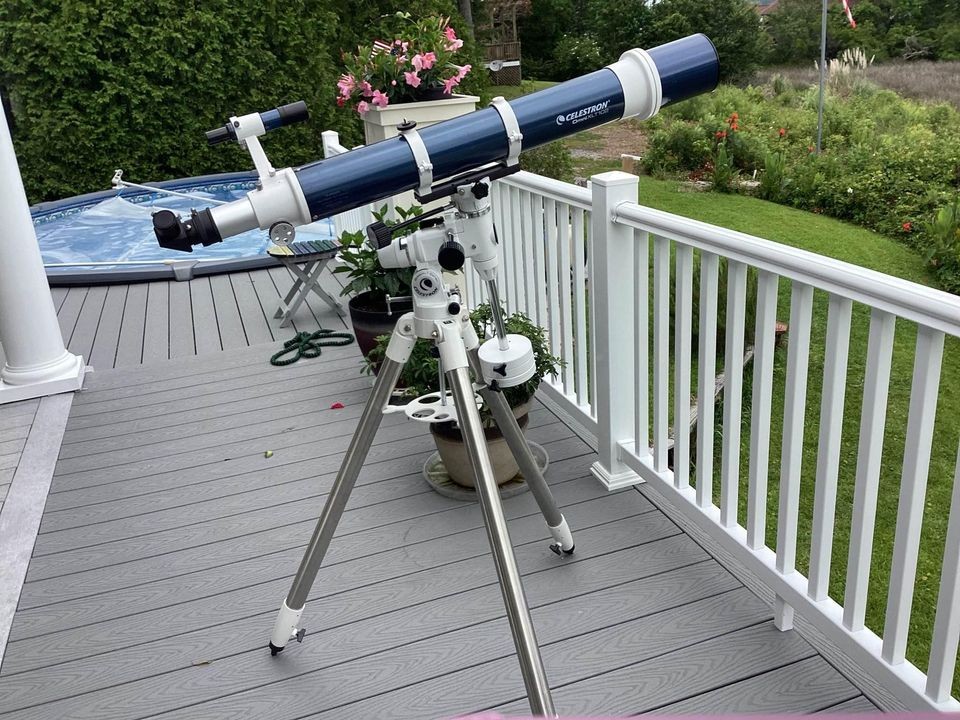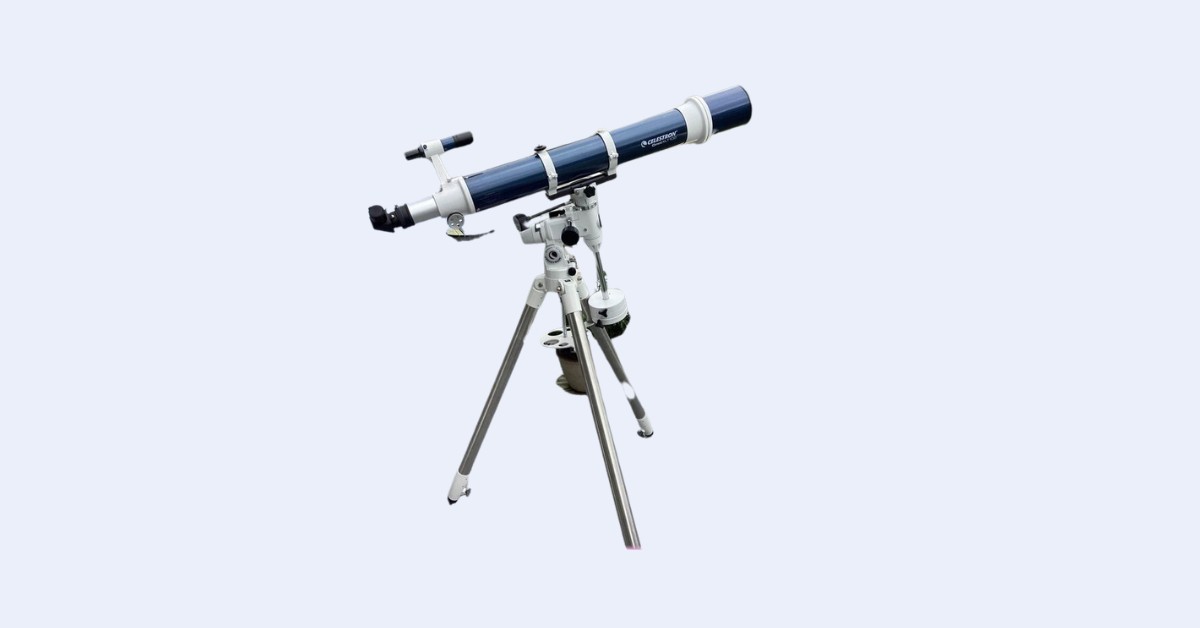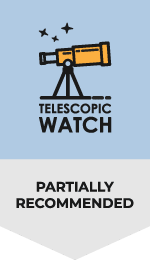The Optical Tube
The Celestron Omni XLT 102 is a 102mm (4”) f/9.8 refractor with a focal length of 1000mm. As is typical at this price range, the scope is a Fraunhofer achromatic doublet using 2 lens elements: A crown glass lens at the front, and a flint glass lens element behind it, separated by small foil spacers. A doublet achromat at this size and speed will have some obvious chromatic aberration on bright targets, such as the Moon, planets, and stars above magnitude 2-3 or so. If you want to eliminate this issue entirely, you’ll need an ED doublet or triplet refractor; a yellow or minus-violet filter reduces the Omni XLT 102’s chromatic aberration, but on the whole, it does not affect sharpness that much. The objective lens is multi-coated, as with any good refractor; the “StarBright XLT” multi-coatings are just marketing buzz.
The Omni XLT 102’s lens can be collimated with a set of 6 push-pull hex screws on the cell. This is handy in case the scope were to ever go out of alignment, though the likelihood is low.
The Omni XLT 102 features a 2” rack-and-pinion focuser, which is rather basic in design and mediocre in quality but at least all-metal. A 1.25” adapter is provided to use the stock 1.25” diagonal and accessories. The stock 1.25” adapter also has T threads to attach a DSLR camera with a T ring, though neither the scope nor the mount are designed with astrophotography in mind.
To attach to a mount like the provided CG-4, the Omni XLT 102 optical tube rests inside a pair of felt-lined metal tube rings, which are bolted to a Vixen-style dovetail. The tube can be slid in the rings for balance on the mount’s declination axis as well as rotated to put the finder/diagonal in a different position.
Accessories
The accessories that come with the Omni XLT telescopes are minimalistic. Included with the 102mm refractor are a 25mm LET eyepiece, a 6×30 finder, and a 1.25″ prism star diagonal. The 25mm LET is a 3-element ocular that has a unique long-eye relief design and is adequate for low-power viewing, with a 52-degree apparent field of view, translating to a magnification of 40x and a true field of 1.3 degrees, or 2.5x the angular diameter of the full Moon in the sky, with the Omni XLT 102mm f/10 optical tube. A 32mm or 40mm Plossl will provide lower magnification and a slightly wider field of view; a 2” diagonal and eyepieces will unlock a greater potential field of view with the Omni XLT 102, but the provided 1.25” prism is very well-made and might be all you need.
The Omni’s provided 6×30 finder is not ideal; it produces dim images and can be uncomfortable to use. A red dot sight might be easier to use.
The Omni CG-4 Mount

The Omni CG-4 mount is a top-of-the-line piece of equipment. The CG-4 is a German equatorial mount with the same parts as the Orion SkyView Pro and Sky-Watcher EQM-35, though the CG-4 is all-manual with no electronics by default. In many ways it resembles a scaled-down CG-5/Advanced VX mount. The Omni CG-4 is intended to hold up to a 20 lb payload, though a 15 lb limit is more realistic, and it uses a standard Vixen-style dovetail saddle to hold telescopes such as the Omni XLT 102 optical tube. A pair of counterweights, one 7 lb and one 4 lb, are provided to balance the mount’s right ascension axis with the Omni XLT 102 optical tube.
It’s important to note that this mount should not be confused with the older, black CG-4 model, which features legs made of extruded aluminum and cheap plastic parts. The Omni CG-4 uses steel 1.75” diameter tripod legs. For hands-free tracking and slewing, you can upgrade the CG-4 with single-axis or dual-axis motor drives. Additionally, a polar scope is available to enable precise polar alignment.
Even with the tripod legs fully extended (which decreases stability), the CG-4 puts the eyepiece of the Omni XLT 102 at an uncomfortably low height when the scope is aimed high in the sky – a common problem with long refractors. The only solution is to build or buy some sort of pier extension.
Should I buy a Used Celestron Omni XLT 102?
The Omni XLT 102 is a durable telescope with sturdy construction and uncomplicated refracting optics, making it hard to damage by those who may not be the most careful with their equipment and extremely obvious for even a neophyte to notice something is wrong. Any damage to the objective lens, optical tube, or mount/tripod should be readily noticeable. It’s worth noting that units missing accessories should be priced accordingly lower – a basic new finder, diagonal, and low-power eyepiece can add up to around $100 USD to buy separately.
Alternative Recommendations
The Omni XLT 102 is not one of our top picks in its price range due to the overall lack of value and convenience it delivers. Here are some of our favorite alternatives, both refractors and reflectors.
Under $550
- The Sky-Watcher Virtuoso GTi 150P offers a huge field of view, fully motorized tracking and GoTo, and superior light-collecting and resolving power to the Omni XLT 102 on account of its larger aperture, with the ability to be aimed manually alongside its WiFi-operated GoTo system and featuring a collapsible tube for maximum portability. The manual Heritage 150P is identical in design and performance minus the GoTo and motors, while the Heritage 130P is also an excellent choice at a bargain price.
- The Popular Science Celestron StarSense Explorer DX 100AZ is a fast f/6.6 refractor with identical light-gathering power to the Omni XLT 102 but more chromatic aberration. However, it delivers a wider field of view with 1.25” eyepieces and its StarSense Explorer technology coupled to a simple alt-azimuth mount makes it quick and easy to find your way around the night sky.
- The Celestron Omni XLT 102AZ features the same optics and mount as the StarSense Explorer DX 100AZ, but with the Omni metal rack-and-pinion focuser and no StarSense Explorer technology. It is available in a StarSense Explorer configuration as the DX 102 AZ, as well.
- The Orion SkyQuest XT6 Classic is a fairly standard freestanding 6” f/8 Dobsonian, with slightly better light-gathering and resolving characteristics than the Omni XLT 102 and a similar maximum field of view. It’s not any more compact than a standard 8” Dobsonian, however.
$550-$800
- The Apertura AD8/Zhumell Z8/Orion SkyLine 8 offers twice the resolution and 4x the light-gathering power of the Omni XLT 102 along with features such as a 2” dual-speed Crayford focuser and a high-quality accessory bundle.
- The Celestron StarSense Explorer 8” Dobsonian features a lightweight Dobsonian mount, plenty of capability thanks to its 8” aperture, and the Celestron StarSense Explorer technology to aid you in navigating the night sky. However, few accessories are included despite this scope’s relatively high price tag.
- The Explore Scientific FirstLight 8” Dobsonian has a well-designed Dobsonian mount with silky-smooth bearings and a rotating tube assembly thanks to the provided rings. It also sports a high-quality reflex sight finder and 2” heavy-duty Crayford focuser. The only drawback is that the sole included eyepiece is not very good.
- The Explore Scientific 10” Hybrid Dobsonian has even more light-collecting and resolving power than an 8” Dobsonian and comes in a collapsible truss tube, taking up a fraction as much space. However, it doesn’t include many useful accessories and properly equipping it can get expensive fast.
Aftermarket Accessory Recommendations
A 2” star diagonal vastly increases the field of view possible with the Omni XLT 102 from a maximum of 1.6 degrees to up to 2.8 degrees, making it ideal for locating and viewing even the largest deep-sky objects. We recommend the Apertura dielectric unit for its quality, light weight and price. Using a 2” wide-angle eyepiece such as the 38mm Apertura SWA (26x) will enable you to enjoy stunning wide-field vistas of nebulae and star clusters.
Of course, you’ll also want eyepieces for higher magnifications too. A 15mm redline/goldline (67x) makes for a good medium-power ocular, while a 9mm goldline (111x) and Celestron 5mm X-Cel LX (200x) are ideal for maxing out the Omni XLT 102’s capabilities on the Moon, planets, and double stars. The Omni XLT 102 can handle up to around 200-240x before running out of light-gathering and resolving power on the brightest targets.
A UHC nebula filter such as the Orion UltraBlock improves contrast on nebulae under light-polluted skies with almost any telescope and brings out otherwise invisible objects and details under good conditions. If you are getting a 2” diagonal, stick with the 2” version, which will thread onto your 1.25” adapter for use with either size ocular.
Since the CG-4 mount can be adapted to take a motor drive, you may wish to install Celestron’s dual-axis drive kit on your Omni XLT 102’s CG-4 mount. It replaces the slow-motion cables with push-button, variable-speed controls, as well as automatically tracking at lunar, solar, or sidereal speeds. However, it is quite expensive and may or may not be worth the price of upgrading.
Lastly, as previously mentioned, you may wish to replace the Omni XLT 102’s 6×30 finder with a red dot sight. This will make aiming a little easier, though it is technically less accurate than a 6×30 and won’t show you stars fainter than what your naked eye can see.
What can you see?
The Omni XLT 102’s long 1000mm focal length limits its field of view somewhat without a 2” diagonal and eyepieces, though it’s still shorter in focal length than most freestanding Dobsonians. Open star clusters like the Double Cluster or the Pleiades (M45) look lovely, as do smaller ones like M35 and M11. Globular star clusters, with the exception of Omega Centauri, are usually unresolved fuzzy dots with only 4” of aperture, though on a very good night under a dark sky you can tell that the brightest globulars, such as M13 and M22, look a little grainy at high magnifications with the Omni XLT 102. Like globular clusters, planetary nebulae are usually lackluster with such a small instrument, apart from the famed Ring (M57) and Dumbbell (M27), which show their distinct shapes. Fortunately, plenty of colorful double stars can be split with the Omni XLT 102, and the scope is razor-sharp, delivering perfect pinpoint stars in the case of all but the brightest ones, which will be moderately affected by its chromatic aberration.
Larger extended deep-sky objects such as nebulae and galaxies look best under dark skies, and in the case of the latter, they may be entirely invisible if you have to contend with large amounts of light pollution. However, bright nebulae like Orion (M42) and the Lagoon (M8) still look excellent from suburban skies, particularly with a UHC nebula filter to improve contrast, while under dark skies a UHC brings out the Veil Nebula supernova remnant too. Galaxies are washed out entirely by severe light pollution and largely too dim for a 4” telescope to show you much in the way of detail, but you can pick out the dust lanes and satellite galaxies of the Andromeda Galaxy (M31) and see groups like the Leo Triplet and Virgo Cluster too, though even the brightest galaxies can appear rather faint and are usually devoid of any detail.
The Omni XLT 102 is a great scope for viewing the Moon and planets – the chromatic aberration at this size and relatively slow focal ratio has little impact on actual detail, though at only 4” of aperture, a 5-6” reflector or catadioptric will beat it, and a larger scope easily shows more on a good enough night where conditions permit. The Moon shows thousands of craters, ridges, cracks, mountains and other details, while the phases of Mercury and Venus are easily resolved with the Omni XLT 102. Mars shows its polar ice caps and any ongoing dust storms, while fine detail in the form of dark surface markings can be seen only when the planet is at its closest to Earth and thus attains its maximum angular size. Jupiter’s colorful atmosphere is magnificent, with its equatorial cloud belts, vivid small storms, and the Great Red Spot revealed by the Omni XLT 102’s sharp optics. The moons appear as tiny disks with inky-black shadows during transits, too. You’ll also be able to see the Cassini Division in Saturn’s rings and a few of the gas giant’s moons, and its own dull cloud bands, while Uranus and Neptune are tiny green and blue dots which may be hard to distinguish from stars at all; Neptune’s moon Triton is just beyond the reach of a 4” refractor while Uranus’ quartet of observable moons, along with Pluto, require an 8-10” or larger instrument to see.
Astrophotography
The chromatic aberration of the Omni XLT 102 will wreck images far more than the minor inconvenience it causes for visual use, and its 4” of aperture is just not enough for serious planetary astrophotography, while its slow f/9.8 speed makes it a poor choice for deep-sky imaging. The Omni CG-4 mount would require drives for astrophotography but cannot be easily guided and the simple servo drive kit would not produce nearly accurate enough tracking for anything but the smallest telescopes and camera lenses anyway. As such, the Omni XLT 102 is not suitable for any sort of astrophotography, be it Solar System or deep-sky.




I purchased the Celestron Omni xlt 102 as an OTA only from Highpoint Scientific recently. I usually use it on an AVX mount. I did upgrade to an AT 10×50 RACI finder and a Rigel reflex finder. I also do use a two inch diagonal for star fields and my higher power 1 1/4 eyepieces for solar system viewing. I agree that the optics are first rate. Star clusters and double stars are outstanding in my opinion. I never found the chromatic aberration to be a significant problem in truth even at higher powers on Jupiter. Now it doesn’t tempt me to sell my AT-111 triplet, but I really do enjoy using this f-10, 102 mm refractor. It reminds me of my first telescope gifted to me as a ten year old in 1958 but this Omni xlt 102 is far superior. I consider it a bargain at its price point. I would be more generous in the star rating department as well. However you were judging it vs other scopes in the same price range and I realize that a 6 inch DOB might be a better since it comes with a more intuitive mount and not needing the upgrades that I mentioned above. Thanks for doing these reviews however, it was fair, given your rating criteria and can be valuable for newbie astronomers.